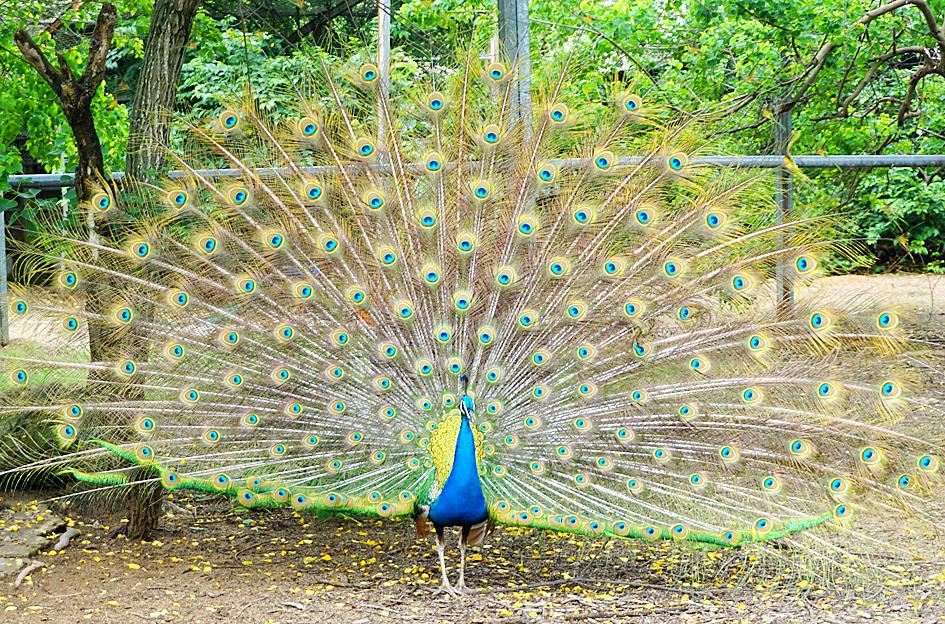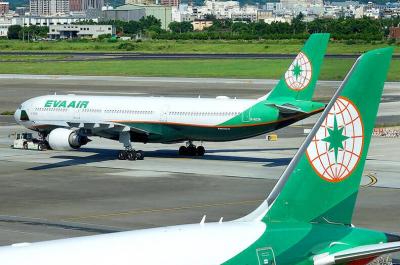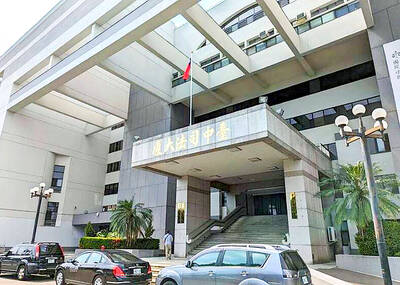Although Kinmen’s peafowl population poses an “interesting” potential for tourism, the Kinmen County Government on Friday said that it would prioritize trying to eradicate the invasive species, as they are increasingly threatening native species and agriculture.
First brought to the outlying islands for a zoo, the peafowl were moved to the county’s Livestock Research Institute after the establishment of Kinmen National Park in 1995.
Four years later, 14 birds escaped into the wild when Typhoon Dan damaged their enclosure.

Photo: CNA
A survey commissioned by the institute found that their numbers have been rising steadily ever since, with a particularly large increase last year.
While the population grew to 252 in the 12 years until 2011, the population grew by 450 birds to 1,353 from 2019 to last year, the survey showed.
The Kinmen Economic Affairs Department’s agriculture and forestry section estimated that there are now between 1,000 and 2,000 peafowl in the county.
The birds are particularly problematic for farmers, as they feed on crops and spent grain from sorghum distillation used as livestock fodder.
Their piercing cries are also a source of consternation for residents, especially during mating season, with a county government hotline often receiving complaints about peafowl noise as early as 3am.
They even threaten aviation and road safety, as many have been spotted flying close to Kinmen Shangyi Airport and roads, the section said.
Since the county determined that the peafowl population growth has become untenable, it has been implementing measures to mitigate their spread, section chief Cheng Hsiang-ting (鄭向廷) said.
The Forestry Bureau in 2010 granted the county a subsidy to remove the peafowl, while a program offering residents NT$600 per captured bird has been in place since 2018, Cheng said.
About 30 peafowl are captured through the program each year, he said, adding that this is not nearly enough to catch up with population growth.
About 30 of the captured birds are at the institute, where they would be looked after until they die of natural causes, he said.
Chen Kuang-yao (陳光耀), who heads the Kinmen Wildlife Rehabilitation and Conservation Association, said that the peafowl would inevitably damage the local ecosystem.
Originally from India, the omnivorous birds lack natural predators on Kinmen and compete with other animals for food, eating not only crops, but also snakes and other small animals, he said.
If not contained, the peafowl could drive native species to extinction, he added.
The county has responded to the threat by commissioning a team of researchers to capture and remove the birds.
The team originally used traps, but received pushback from farmers, as they sometimes ensnare cattle, said Chang Hsueh-wen (張學文), a professor in National Sun Yat-sen University’s Department of Biological Sciences who leads the team.
However, Chang said that they are optimistic about a new method that involves capturing the birds with stationary nets.
As for whether it is possible to effectively eradicate Kinmen’s peafowl, the department said it was still figuring it out.
Using for example the African sacred ibis, a wading bird that was introduced to Taiwan in 1979, Chang said that it was only two years ago that the bureau decided to cull the population by shooting them.
However, this method is not suitable for the peafowl, as the ibis are found on unpopulated riverbanks, while peafowl mostly stay in forests and near grazing pastures, he added.
However, some Kinmen residents have built businesses around the call for help controlling the population.
Aside from capturing peafowl for government reward, Lee Tse-li (李策勵), a retired teacher, also set up a farm where people can marvel at the birds and even buy them.
A peafowl can sell for much higher than the NT$600 reward, Lee said.
The bird is even becoming a popular ingredient in the local cuisine, fetching a handsome price for skilled crossbow hunters such as Lee.
From a tourism perspective, the peafowl are undeniably beneficial, Kinmen Tourism Department Director Ting Chien-kang (丁健剛) said.
However, it would only invite ridicule if the county is forced to cull the animals after promoting them to tourists because the ecological consequences became too severe, Ting added.
Experts say that promoting peafowl tourism might be worthwhile if the income is enough to offset agricultural losses, but it is too early to say whether it would work for Kinmen.

The first global hotel Keys Selection by the Michelin Guide includes four hotels in Taiwan, Michelin announced yesterday. All four received the “Michelin One Key,” indicating guests are to experience a “very special stay” at any of the locations as the establishments are “a true gem with personality. Service always goes the extra mile, and the hotel provides much more than others in its price range.” Of the four hotels, three are located in Taipei and one in Taichung. In Taipei, the One Key accolades were awarded to the Capella Taipei, Kimpton Da An Taipei and Mandarin Oriental Taipei. Capella Taipei was described by

EVA Airways today confirmed the death of a flight attendant on Saturday upon their return to Taiwan and said an internal investigation has been launched, as criticism mounted over a social media post accusing the airline of failing to offer sufficient employee protections. According to the post, the flight attendant complained of feeling sick on board a flight, but was unable to take sick leave or access medical care. The crew member allegedly did not receive assistance from the chief purser, who failed to heed their requests for medical attention or call an ambulance once the flight landed, the post said. As sick

The Taichung District Court yesterday confirmed its final ruling that the marriage between teenage heir Lai (賴) and a man surnamed Hsia (夏) was legally invalid, preventing Hsia from inheriting Lai’s NT$500 million (US$16.37 million) estate. The court confirmed that Hsia chose not to appeal the civil judgement after the court handed down its ruling in June, making the decision final. In the June ruling, the court said that Lai, 18, and Hsia, 26, showed “no mutual admiration before the marriage” and that their interactions were “distant and unfamiliar.” The judge concluded that the couple lacked the “true intention of

A drunk woman was sexually assaulted inside a crowded concourse of Taipei Railway Station on Thursday last week before a foreign tourist notified police, leading to calls for better education on bystander intervention and review of security infrastructure. The man, surnamed Chiu (邱), was taken into custody on charges of sexual assault, taking advantage of the woman’s condition and public indecency. Police discovered that Chiu was a fugitive with prior convictions for vehicle theft. He has been taken into custody and is to complete his unserved six-month sentence, police said. On Thursday last week, Chiu was seen wearing a white